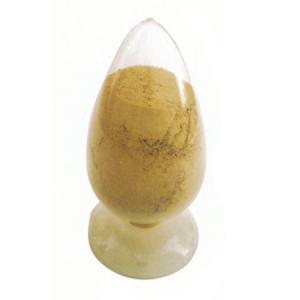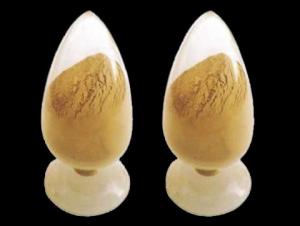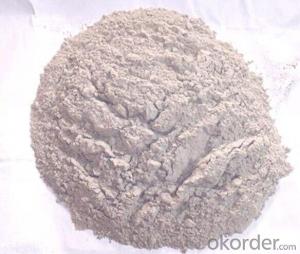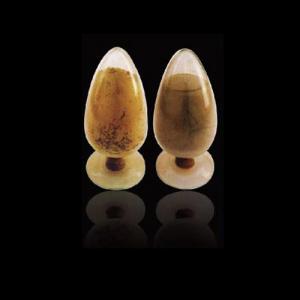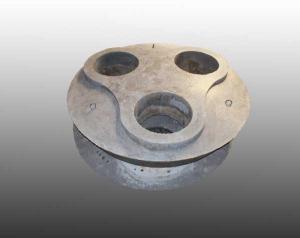Painting Material for Tundish
- Loading Port:
- China Main Port
- Payment Terms:
- TT or L/C
- Min Order Qty:
- 2 Mt m.t.
- Supply Capability:
- 5000 Tons Per Month m.t./month
OKorder Service Pledge
OKorder Financial Service
You Might Also Like
General Information of Painting Material for Tundish
Made as per international standards, ALRE painting material for tundish is known for its excellent corrosion resistance, long operating life and high refractoriness. Further, these can be provided in different specifications as required by the clients.
Technical data of Painting Material for Tundish
Item | Painting material for tundish | ||||
Al2O3 | % | ≥ | — | ||
MgO | % | ≥ | 60-85 | ||
CaO | % | ≤ | — | ||
SiO2 | % | ≤ | — | ||
SiO2+ Fe2O3+ Al2O3 | % | ≤ | |||
Bulk density ≥ | g/cm3 | 2.0 | |||
C.C.S. (MPa) ≥ | 110℃×24hrs | 5.0 | |||
1500℃×3hrs | 8.0 | ||||
M.O.R.(MPa) ≥ | 110℃×24hrs | — | |||
1500℃×3hrs | — | ||||
Refractoriness (℃) ≥ | — | ||||
Grain size (mm) ≤ | 3 | ||||
Permanent linear change | 1500℃×2hrs | — | |||
1500℃×3hrs | -2.5~-1.0 | ||||
Life time (hr) | 10-40 | ||||
Production line and Packing of Painting Material for Tundish
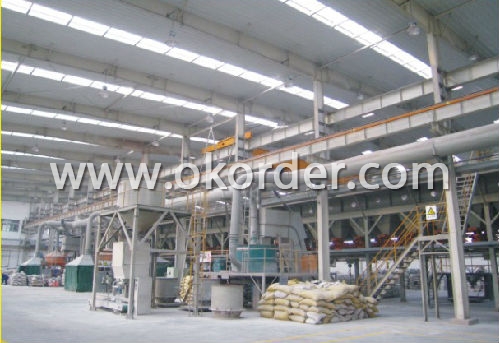

Feature of Painting Material for Tundish
Easy execution and mending
Excellent abrasive resistance performance
Excellent corrosion and scouring resistance of iron steel
Application of Painting Material for Tundish
ALRE painting material for tundish could be used widely for ladel and tundish of stell and iron industry.
- Q:What are the key characteristics of monolithic refractories for electric arc furnace applications?
- Monolithic refractories designed for electric arc furnace applications possess several crucial qualities that render them suitable for the challenging conditions and extreme temperatures encountered in these environments. To begin with, monolithic refractories exhibit exceptional resistance to thermal shock. Electric arc furnaces operate at exceedingly high temperatures, and the rapid fluctuations in temperature during the melting and refining processes can subject the refractories to significant thermal stress. Monolithic refractories, however, are engineered to endure these thermal shocks without developing cracks or spalling, thereby guaranteeing the durability and performance of the lining. Moreover, monolithic refractories boast a high resistance to chemical attack. Electric arc furnaces involve the melting and refining of diverse metals and alloys, which can generate highly corrosive atmospheres. Monolithic refractories incorporate chemically inert materials and additives that bestow resistance against the corrosive impact of molten metals and slag, safeguarding the lining against chemical deterioration. Another noteworthy characteristic of monolithic refractories for electric arc furnace applications is their exceptional refractoriness. Refractoriness denotes a material's ability to retain its strength and integrity at elevated temperatures. Electric arc furnaces typically operate at temperatures surpassing 1500°C, and monolithic refractories are specifically engineered to endure these extreme conditions without experiencing substantial loss of properties or degradation. Furthermore, monolithic refractories offer efficient thermal conductivity. This property facilitates efficient heat transfer throughout the lining, ensuring uniform heating and melting of the charge material. It also helps minimize the occurrence of hot spots and thermal gradients, which can result in uneven wear and premature failure of the lining. Lastly, monolithic refractories are renowned for their ease of installation and repair. Unlike traditional brick or block refractories, monolithic materials can be cast, sprayed, or rammed into place, eliminating the need for intricate masonry work. This not only saves time and labor but also enables convenient maintenance and repair of the lining, reducing downtime and enhancing overall furnace efficiency. In conclusion, monolithic refractories for electric arc furnace applications possess exceptional thermal shock resistance, high chemical resistance, high refractoriness, efficient thermal conductivity, and ease of installation and repair. These qualities render monolithic refractories ideal for withstanding the harsh conditions and demanding requirements of electric arc furnace operations.
- Q:What are the main factors affecting the erosion resistance of monolithic refractories?
- The main factors affecting the erosion resistance of monolithic refractories include the type and composition of the refractory material, the operating temperature and environment, the mechanical strength and density of the refractory, and the presence of impurities or contaminants. Additionally, the design and installation of the refractory lining, as well as the method of installation, can also influence its erosion resistance.
- Q:What are the recommended curing and drying procedures for monolithic refractories?
- The recommended curing and drying procedures for monolithic refractories typically involve a gradual heating process to ensure proper bonding and removal of any moisture. This process usually starts with a preheat at a low temperature to eliminate any residual water, followed by a controlled temperature increase over a specific duration to achieve the desired strength and stability. It is essential to follow the manufacturer's guidelines and consider the specific composition and thickness of the refractory material to ensure optimal curing and drying.
- Q:What are the latest advancements in monolithic refractories for the iron and steel industry?
- Some of the latest advancements in monolithic refractories for the iron and steel industry include the development of high-performance materials with enhanced thermal shock resistance, improved corrosion resistance, and increased durability. These advancements have been achieved through the incorporation of advanced additives and binders, as well as the utilization of new manufacturing techniques such as spray drying and rapid heat curing. Additionally, there have been advancements in the design of monolithic refractory shapes and installation techniques to optimize their performance and increase their lifespan in the demanding environments of the iron and steel industry.
- Q:What are the benefits of using monolithic refractories in the iron and steel industry?
- There are several benefits of using monolithic refractories in the iron and steel industry. Firstly, monolithic refractories offer excellent thermal shock resistance, allowing them to withstand extreme temperature changes without cracking or spalling. This is crucial in the iron and steel industry, where materials are subjected to high temperatures during processes like melting, casting, and heat treatment. Secondly, monolithic refractories have superior corrosion resistance, making them highly durable against the corrosive effects of molten metals and slag. This is particularly important in the iron and steel industry, where materials come into contact with aggressive molten iron, steel, and various chemical compounds. Additionally, monolithic refractories provide excellent mechanical strength and abrasion resistance. They have the ability to withstand mechanical stress, vibrations, and impacts typically encountered in the iron and steel industry. This ensures longer refractory lifespan, reduces downtime for repairs or replacements, and improves overall operational efficiency. Moreover, monolithic refractories offer ease of installation and repair. Unlike traditional refractory bricks that require complex and time-consuming masonry work, monolithic refractories can be installed quickly and easily using simple methods like casting, gunning, or spraying. This saves time and labor costs during initial installation and subsequent maintenance or repairs. Furthermore, monolithic refractories provide flexibility in design and application. They can be tailored to specific shapes and sizes, allowing for customized linings in different parts of the iron and steel manufacturing process. This versatility enhances the overall efficiency and effectiveness of refractory linings, optimizing the production output and ensuring consistent quality of the finished iron and steel products. In conclusion, the benefits of using monolithic refractories in the iron and steel industry are numerous. They offer exceptional thermal shock resistance, corrosion resistance, mechanical strength, and abrasion resistance. They are easy to install and repair, and their flexibility allows for customized designs. Overall, monolithic refractories contribute to improved productivity, reduced downtime, and enhanced product quality in the iron and steel industry.
- Q:How do monolithic refractories contribute to reducing emissions in iron and steel processes?
- The reduction of emissions in iron and steel processes is greatly aided by the use of monolithic refractories, which offer a more efficient and sustainable lining solution compared to traditional brick refractories. To begin with, monolithic refractories possess a homogeneous structure that allows for easier installation and repair. This characteristic reduces the amount of time needed for maintenance, ultimately leading to increased productivity and decreased emissions. In contrast, brick refractories require more labor-intensive and time-consuming procedures for installation and repair, resulting in longer shutdown periods and higher emissions. Additionally, monolithic refractories demonstrate superior thermal insulation properties. By minimizing heat loss from furnaces or kilns, they enhance energy efficiency and decrease the amount of fuel required to reach the desired temperature. This reduction in fuel consumption directly translates into lower emissions of greenhouse gases, such as carbon dioxide, which contributes to the overall environmental sustainability of iron and steel processes. Furthermore, monolithic refractories possess excellent resistance to both thermal and chemical wear, thereby enhancing the durability and lifespan of the lining. This increased durability reduces the frequency at which refractories need to be replaced, resulting in reduced waste generation and resource consumption. By extending the service life of the lining, monolithic refractories contribute to the reduction of the environmental impact associated with the production and disposal of refractory materials. Moreover, monolithic refractories can be formulated with specialized compositions and additives to improve their resistance to corrosion and erosion, which are common challenges in iron and steel processes. By minimizing the wear and tear on the refractory lining, they help maintain the integrity of furnaces and kilns, preventing the leakage of harmful gases and pollutants that would otherwise contribute to emissions. In conclusion, monolithic refractories aid in the reduction of emissions in iron and steel processes through their ease of installation and repair, superior thermal insulation properties, increased durability, and resistance to corrosion and erosion. By optimizing energy efficiency, minimizing downtime, and reducing waste generation, monolithic refractories provide a sustainable solution for the industry, aligning with global efforts to combat climate change and promote environmental stewardship.
- Q:How do monolithic refractories respond to changes in thermal conditions?
- Monolithic refractories have the ability to withstand and adapt to changes in thermal conditions. They have a high thermal shock resistance, meaning they can handle rapid changes in temperature without cracking or breaking. Additionally, they exhibit good thermal conductivity, allowing them to efficiently conduct and distribute heat. Overall, monolithic refractories demonstrate a stable and reliable response to changes in thermal conditions.
- Q:How do monolithic refractories impact the overall productivity of iron and steel operations?
- The overall productivity of iron and steel operations is greatly enhanced by monolithic refractories. These refractories are specifically designed to withstand extreme temperatures, chemical reactions, and mechanical stress that occur during production. One important way that monolithic refractories impact productivity is by reducing downtime and increasing operational efficiency. These refractories have high thermal conductivity and are resistant to thermal shock, allowing them to maintain stable temperatures within the furnace. This prevents sudden temperature fluctuations that can lead to equipment failure and production delays. As a result, the production process can continue uninterrupted, leading to increased productivity. Furthermore, monolithic refractories offer superior corrosion resistance, preventing the erosion and degradation of furnace linings. This resistance to chemical attacks from molten metals and slag helps prolong the lifespan of the refractory lining, reducing the need for repairs and replacements. This leads to less downtime and higher productivity for iron and steel operations. Additionally, monolithic refractories enable faster installation and repair processes compared to traditional brick refractories. They have a fluid-like consistency that makes application and shaping easy, resulting in shorter installation and curing times. This quick turnaround time minimizes production interruptions during repairs or maintenance, further increasing overall productivity. Moreover, the use of monolithic refractories can optimize energy consumption in iron and steel operations. Their excellent insulation properties help retain heat within the furnace, reducing heat loss and energy waste. This improves energy efficiency and leads to cost savings, ultimately contributing to increased productivity and profitability. In conclusion, monolithic refractories have a significant impact on the productivity of iron and steel operations. Their ability to withstand extreme conditions, reduce downtime, resist corrosion, facilitate quick repairs, and optimize energy consumption all contribute to improved efficiency and productivity in the industry.
- Q:How do monolithic refractories contribute to the overall safety of iron and steel operations?
- Monolithic refractories play a crucial role in ensuring the overall safety of iron and steel operations by providing several important benefits. Firstly, monolithic refractories are known for their high thermal insulation properties, which means they can effectively withstand extreme temperatures and prevent heat loss. This is particularly important in iron and steel operations, where high temperatures are involved in various processes such as melting, casting, and heat treatment. By minimizing heat loss, monolithic refractories help in maintaining a stable temperature environment, reducing the risk of accidents and ensuring the safety of personnel. Secondly, monolithic refractories offer excellent resistance to chemical attacks. In iron and steel operations, various chemicals and gases are present that can corrode and deteriorate the lining of furnaces, ladles, and other equipment. By providing a protective barrier, monolithic refractories prevent the penetration of these corrosive substances, thus extending the lifespan of the equipment and reducing the likelihood of failures or leaks that could pose safety hazards. Additionally, monolithic refractories are known for their structural integrity and high mechanical strength. In iron and steel operations, heavy loads and stresses are common, especially during the handling and movement of molten metal and raw materials. Monolithic refractories can withstand these stresses without cracking or collapsing, ensuring the structural stability of the equipment and minimizing the risk of accidents or equipment failure. Furthermore, monolithic refractories offer excellent thermal shock resistance. During iron and steel operations, sudden temperature changes can occur due to the introduction of cold materials or liquids into hot equipment. This thermal shock can cause cracking and spalling of the refractory lining, which can compromise the safety and efficiency of the operation. Monolithic refractories, with their ability to withstand thermal shock, help in minimizing the risk of unexpected failures and maintaining the overall safety of the operation. In conclusion, monolithic refractories contribute significantly to the overall safety of iron and steel operations by providing high thermal insulation, chemical resistance, structural integrity, and thermal shock resistance. By ensuring a stable temperature environment, protecting against chemical attacks, withstanding heavy loads, and resisting thermal shock, monolithic refractories help in preventing accidents, equipment failures, and potential hazards, thus creating a safer working environment for personnel in the iron and steel industry.
- Q:How do monolithic refractories withstand the mechanical impacts in furnace door applications?
- Monolithic refractories are designed to withstand mechanical impacts in furnace door applications due to their unique properties and composition. These refractories are made from a single piece of material, which eliminates the need for joints or seams that are prone to cracking or failure under mechanical stress. One important characteristic of monolithic refractories is their high density, which provides them with excellent strength and resistance to mechanical impacts. Their dense structure makes them less susceptible to cracking or breaking when subjected to sudden or repeated impacts, such as when a furnace door is opened or closed. In addition to their density, monolithic refractories also possess high tensile strength and toughness. These properties allow them to absorb and distribute the energy from mechanical impacts, reducing the risk of damage or failure. This is particularly important in furnace door applications, where the refractories are constantly exposed to the stress of opening and closing the door. Furthermore, monolithic refractories often contain additives or bonding agents that enhance their mechanical properties. These additives can include fibers or aggregates that reinforce the structure and improve resistance to impacts. They can also improve the refractory's ability to withstand thermal cycling, which is common in furnace door applications. Overall, monolithic refractories are specifically engineered to withstand the mechanical impacts encountered in furnace door applications. Their dense, high-strength composition, combined with the use of additives and bonding agents, ensures their durability and longevity in these demanding environments.
1. Manufacturer Overview |
|
|---|---|
| Location | Henan, China |
| Year Established | 2007 |
| Annual Output Value | Above US$ 200 Million |
| Main Markets | North America;Asia;Western Europe;Africa;Russia;Middle East |
| Company Certifications | ISO 9001:2008 |
2. Manufacturer Certificates |
|
|---|---|
| a) Certification Name | |
| Range | |
| Reference | |
| Validity Period | |
3. Manufacturer Capability |
|
|---|---|
| a)Trade Capacity | |
| Nearest Port | Tianjin |
| Export Percentage | 20% - 30% |
| No.of Employees in Trade Department | 10-20 People |
| Language Spoken: | English; Chinese |
| b)Factory Information | |
| Factory Size: | Above 150,000 square meters |
| No. of Production Lines | Above 10 |
| Contract Manufacturing | Installation guide, OEM Service Offered |
| Product Price Range | High; Average |
Send your message to us
Painting Material for Tundish
- Loading Port:
- China Main Port
- Payment Terms:
- TT or L/C
- Min Order Qty:
- 2 Mt m.t.
- Supply Capability:
- 5000 Tons Per Month m.t./month
OKorder Service Pledge
OKorder Financial Service
Similar products
New products
Hot products
Related keywords
